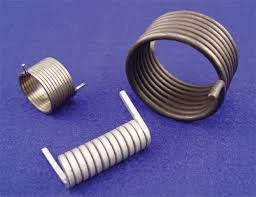
- Mobile Phone
- +8613931874955
- sales@cntcmetal.com
Understanding the Mechanics and Applications of Coil Compression Springs in Various Industries
Understanding Coil Compression Springs Design, Function, and Applications
Coil compression springs are mechanical devices designed to store and release energy when subjected to compressive forces. These springs are essential components in various applications, ranging from automotive to industrial machinery. Their design, function, and applications reflect their versatility and importance in engineering.
Design of Coil Compression Springs
Coil compression springs are typically made from metal wire, which is coiled into a helix shape. The design of these springs is characterized by several key parameters, including wire diameter, coil diameter, total coil height, and the number of active coils. The correct design is crucial as it directly influences the spring's performance.
1. Wire Diameter The thickness of the wire used to manufacture the spring determines its strength. Thicker wires can withstand higher loads, while thinner wires are more flexible and suitable for lighter applications. 2. Coil Diameter The overall diameter of the spring affects how it fits within a mechanism and the amount of energy it can store. A larger diameter coil typically allows for a softer spring, while smaller diameters can create stiffer coefficients. 3. Number of Active Coils This refers to the coils that can actually compress and contribute to the spring's function. The more active coils, the softer the spring. Conversely, fewer active coils yield a stiffer spring, making it suitable for demanding applications.
Functionality of Coil Compression Springs
The primary purpose of a coil compression spring is to resist compressive forces and return to its original shape when the load is removed. This ability to compress and decompress is due to the elasticity of the material used. When a load is applied to the spring, it compresses; when the load is released, the spring returns to its normal shape, releasing the stored energy.
The function of coil compression springs relies on Hooke’s Law, which states that the force exerted by the spring is directly proportional to the displacement of the spring from its rest position. This relationship is mathematically represented as \( F = kx \), where \( F \) is the force, \( k \) is the spring constant, and \( x \) is the displacement. Engineers must calculate these values closely to ensure that the spring performs as intended under operational conditions.
Applications of Coil Compression Springs
coil compression springs

Coil compression springs are found in numerous applications due to their ability to absorb shock, provide resistance, and store energy
. Here are some common applications1. Automotive Industry They are used in various car components, such as shock absorbers, suspension systems, and seats. Their ability to manage impact forces enhances vehicle comfort and stability.
2. Industrial Machinery Many machines rely on coil compression springs for a wide range of functions, including tensioning belts, providing counterbalance, and operating valves.
3. Consumer Products Everyday items like pens, toys, and mattresses utilize compression springs. In pens, for instance, the spring enables the retraction and extension of the ink tip.
4. Aerospace Applications In aircraft systems, springs contribute to the operation of landing gear, control systems, and more. Their lightweight and reliable nature make them indispensable in this industry.
5. Medical Devices Compression springs play a crucial role in various medical equipment, including diagnostic devices and surgical tools, where precision and reliability are paramount.
Conclusion
In conclusion, coil compression springs are integral components across various sectors, from automotive to aerospace. Their unique design and functionality allow them to accommodate a wide range of applications, making them essential in modern engineering. As technology advances, the design and manufacturing of these springs will undoubtedly evolve, bringing about innovations that further enhance their efficiency and effectiveness in numerous applications. Understanding the principles behind coil compression springs is vital for engineers and developers who strive to integrate these components into their designs for optimal performance.
share:
-
Why Sacrificial Formwork Is Redefining Underground ConstructionNewsJun.06,2025
-
The Structural Dynamics of Modern Concrete: How Snake Spacers Revolutionize Flexible ReinforcementNewsJun.06,2025
-
Snake Spacers Smart-Lock Concrete Reinforcement with Surgical PrecisionNewsJun.06,2025
-
Snake Spacers: Reinforcement Precision for Modern Concrete ProjectsNewsJun.06,2025
-
Snake Spacers Powering Concrete's Structural DNANewsJun.06,2025
-
Slither into Success: Snake Spacers' Precision Bite for Unbreakable ReinforcementNewsJun.06,2025
-
Sacrificial Formwork: Building Stronger, Faster, and Safer StructuresNewsJun.06,2025



















